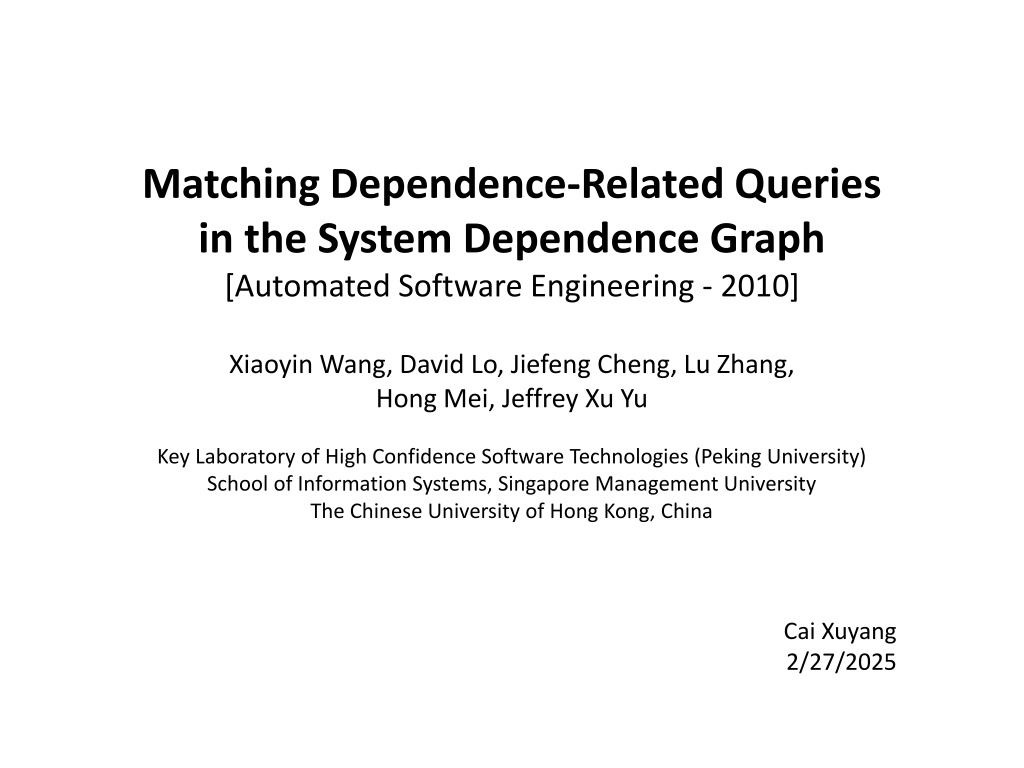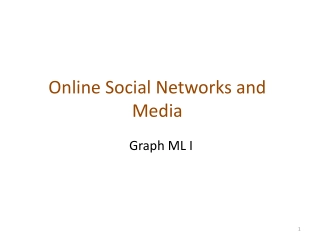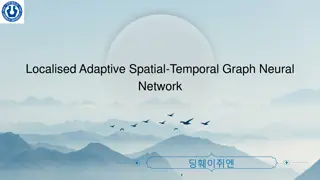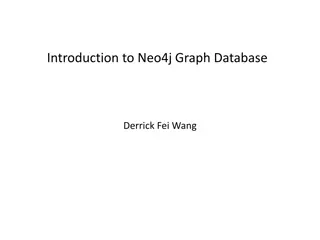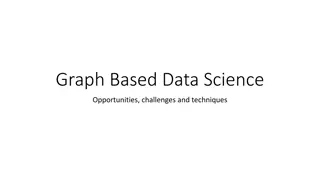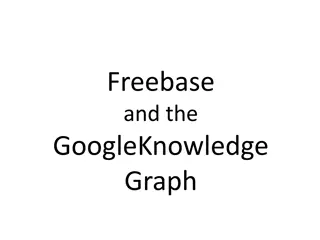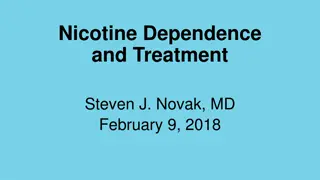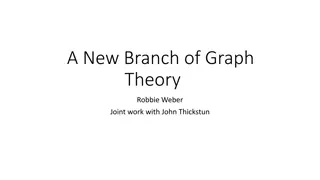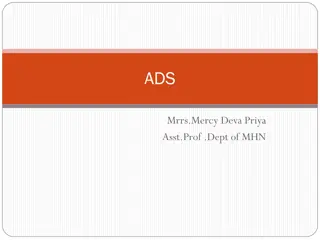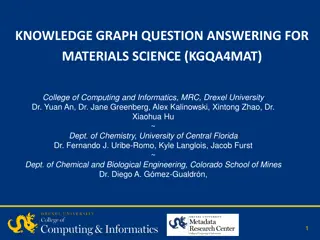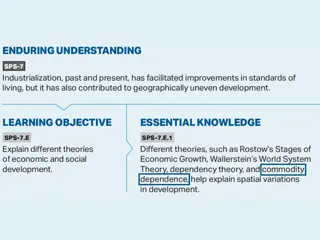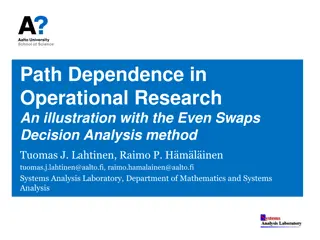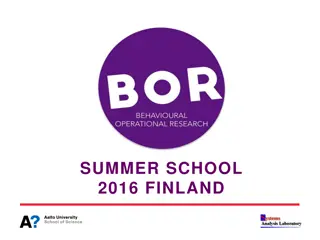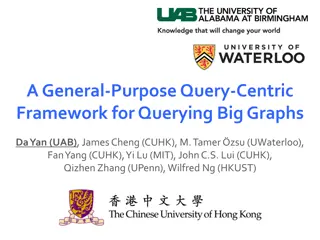Innovative Technique for Querying in System Dependence Graph
Developers often face challenges in locating and changing code elements efficiently. This study introduces a novel method using Dependence Query Language (DQL) to query the System Dependence Graph (SDG) for code element patterns. By transforming queries into graph reachability patterns, this approach enhances code detection compared to traditional methods like code-clone detection and text search.
Uploaded on Feb 27, 2025 | 0 Views
Download Presentation

Please find below an Image/Link to download the presentation.
The content on the website is provided AS IS for your information and personal use only. It may not be sold, licensed, or shared on other websites without obtaining consent from the author. Download presentation by click this link. If you encounter any issues during the download, it is possible that the publisher has removed the file from their server.
E N D
Presentation Transcript
Matching Dependence-Related Queries in the System Dependence Graph [Automated Software Engineering - 2010] Xiaoyin Wang, David Lo, Jiefeng Cheng, Lu Zhang, Hong Mei, Jeffrey Xu Yu Key Laboratory of High Confidence Software Technologies (Peking University) School of Information Systems, Singapore Management University The Chinese University of Hong Kong, China Cai Xuyang 2/27/2025
Outline Introduction Background Approach Evaluation
Introduction Developers often need to apply one change to a number of similar places in the code. Make a programming style change Change the environment of a software system Only find in a few places~ File 1 File 2 Hard to find in other places! File n+1 File n+2 File n Extract common code patterns It is challenging to locate all the places!
Introduction Some possible ways to achieve the similar code detection: Rely on a pre-defined uniform similarity metric to measure the similarity between two places. Code-clone Represent the common characteristics as a regular expression and search in the code for matched code elements. Text search
Introduction Rely on a pre-defined uniform similarity metric to measure the similarity between two places. Code-clone
Introduction Represent the common characteristics as a regular expression and search in the code for matched code elements. Text search Some common characteristics based on control and data dependence relationships cannot be represented as a regular expression.
Introduction A novel technique to locating code elements: Write a query using a language named the Dependence Query Language (DQL) Transform the query into a series of graph reachability patterns Match patterns in the System Dependence Graph (SDG) More effective than code-clone detection and text search
Background System Dependence Graph (SDG) SDG describes the dependence relationships between program points in the source code. A fragment of code CodeSurfer An example system dependence graph
Background System Dependence Graph (SDG)
Background Graph Reachability Indexing and Querying Matching such a pattern in a large graph is computationally expensive. Reachability calculation between all pairs Matching a graph pattern Graph reachability indexing algorithm
Approach Dependence Query Language (DQL) Query Declaration This part allows a developer to declare a list of program points involved in the search.
Approach Dependence Query Language (DQL) Node Descriptions This part allows a developer to describe the properties related to a single program point.
Approach Dependence Query Language (DQL) Relation Descriptions This part allows a developer to describe three kinds of dependence relationships between program points. Target This part allows a developer to indicate which program points in the query are the actual target.
Approach Dependence Query Language (DQL) - Example Node B Node D Node C Node A
Approach SDG Extraction We obtain the system dependence graph (SDG) as follows: Use CodeSurfer to generate an initial SDG from the code. Check each node to see whether the node is a program point of one of the types If so: extract its type, textual presentation, and location Else: only label each node with its type Extract all the edges between nodes and label them as control dependence or data dependence.
Approach Query Transformation To use graph reachability querying to search in the SDG, we need to transform a query described in DQL into one or more queries for graph reachability querying. Transform queries in DQL into query graphs. Split a query with disjunctions of conditions.
Approach Query Transformation Splitting Queries We split the query into the disjunction of a series of sub-queries, each of which contains only conjunctions of conditions. function / control-point A, variable B; A contains "abc" or contains "de"; A dataDepends B; want A function A, variable B; A contains "de"; A dataDepends B; want A function A, variable B; A contains "abc"; A dataDepends B; want A control-point A, variable B; A contains "abc"; A dataDepends B; want A control-point A, variable B; A contains "de"; A dataDepends B; want A
Approach Query Transformation Transforming Conjunctive Queries We transform the query into a query graph in the following way: Transform each program point in the QueryDeclaration part into a node in the query graph. Do not consider the conditions for in query transformation. Transform the type of each program point into the label of the corresponding node. Transform the relationships between program points into edges between nodes.
Approach Query Transformation Transforming Conjunctive Queries Some rules for the transformation
Approach Graph Querying We divide either the query graph or the SDG to two partial graphs. SDG with only data-dep edges SDG SDG with only ctrl-dep edges Results in data- dep query Final result Query Graph with only data-dep edges Results in ctrl- dep query Query Graph Query Graph with only ctrl-dep edges Merge split nodes Reachability indexing algorithm
Approach Result Filtering and Generation We use the conditions that are in the original conjunctive query to filter the results. Program Point Filter Check each node with its corresponding program point in the query. Relationship Filter Verify the textual and structural conditions between program points. OneStep Filter Verify the oneStep conditions between program points.
Evaluation Experimental Settings To evaluate our technique, we applied our technique on four searching tasks in four versions of two different real-world open source C projects: expat and gpsbabel Two projects are of different sizes and from different domains. A code-clone detector: DECKARD Text search V.S.
Evaluation Task One - expat Project Date: 2002-05-17 Comment: Be more careful about failed MALLOC() and REALLOC() calls. This avoids a number of potential memory leaks . Places changed: 2 Method Performance Our Technique Find 2 places and 36 other places Location 1 Code Clone No results Text Search Find 33 places (528 pairs) by searching malloc or realloc Location 2
Evaluation Task Two - expat Project Date: 2002-05-22 Comment: Use "NULL" instead of "0" for NULL pointers. Compare pointers == NULL or != NULL instead of using the implicit point-to- int conversion . Places changed: 8 Our Technique Method Performance Find 8 / 8 places and 200 other places. 178 / 200 are also comparisons between pointer and 0. declaration A, control-point B; A not declareType Native; B oneStep dataDepends A; want B Code Clone No results Text Search Find 2 / 8 places and 70 other places by searching ==0 or !=0 10 / 70 are also comparisons between pointer and 0. Find 8 / 8 places and 829 other places by searching $CTRL DQL
Evaluation Task Three gpsbael Project Date: 2004-10-27 Comment: Aggressively replace open-coded strncpy for space padded strings in various waypoint send functions . Places changed: 37 Method Performance Our Technique Find 37 / 37 places and 25 other places. Code Clone Find 36 / 37 places and 23 other places. Location Example Text Search Find 39 / 37 places and 297 other places by searching for or while .
Evaluation Task Four gpsbael Project Date: 2005-03-21 Comment: Call waypt_new instead of explicit calloc to prepare for external alt invalid indicator . Places changed: 19 Method Performance Location Example Our Technique Find 19 / 19 places and 3 other places. Code Clone Find 17 / 19 places and 9 other places. Text Search Find 19 / 19 places and 86 other places by searching xcalloc .
Evaluation Execution Time We also recorded the execution time of each step in our technique for performing each of the four tasks.
Thanks Thanks Q&A Q&A
